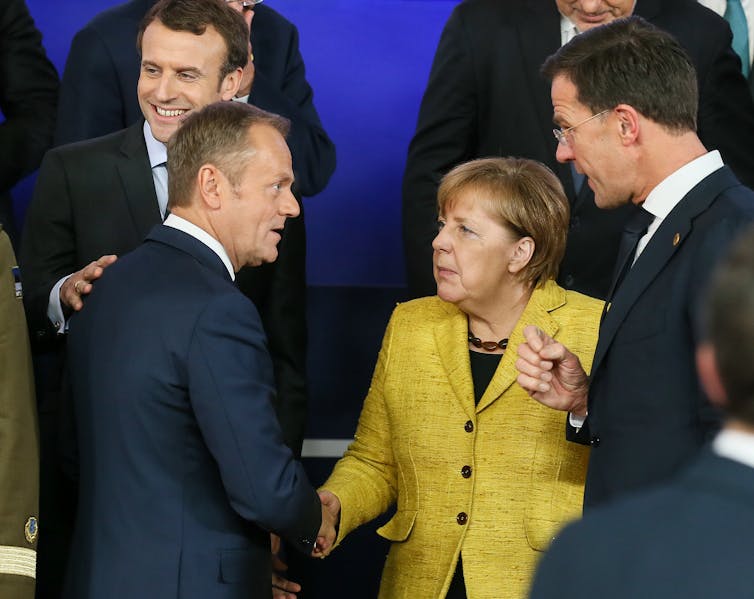The conflict in Ukraine effectively began between 6.30pm and 8.30pm on November 28 2013. This is when Ukraine’s then president, Viktor Yanukovych, confirmed that he was not going to sign an association agreement with the EU – a deal that the Russian government held in contempt. The result is well-known: mass pro-European protests in Ukraine, the ousting of Yanukovych, the annexation of Crimea by Russia, and the protracted war in eastern Ukraine. But why did this happen, and why did it unfold in the way it did?
People have been asking these questions since the Ukrainian conflict began. When Yanukovych made his decision, Herman Van Rompuy, then president of the European Council, reportedly vented his frustration: “You are acting shortsightedly. Ukraine has been negotiating [the EU Association Agreement] for seven years because it thought that it was advantageous. Why should that no longer be the case?” Despite the years of political upheaval, revolution and war that followed Yanukovych’s decision, no single clear answer is forthcoming.
For anyone interested in the future of Europe’s relationship with Russia, grappling with the question of why Ukraine changed course is a crucial part of understanding not just the roots of the Ukrainian conflict, but the deeper geopolitical dynamics that have played out in Central and Eastern Europe for centuries.
As always, in 2013, Russia was worried about the future of its influence in its “near abroad” – the term used in Russian political language to denote former Soviet republics. Towards the end of the year, Russia went out of its way to discourage Yanukovych from signing the agreement with the EU, even resorting to threats; Vladimir Putin’s representative, Ukrainian-born Sergey Glazyev, explained to Yanukovych that “the association agreement is suicide for Ukraine”.
The EU, meanwhile, faced a fiendish dilemma. The situation was neatly summarised by Alexander Kliment of the Eurasia Group during a 2015 House of Lords hearing on the future of EU-Russia relations: the question was whether it was “more important for the European Union to expand its political and economic influence in the former Eastern bloc countries” or “to have a functional, stable and growing relationship with Russia”.
In other words, the EU had two options: to stay as unified and assertive as possible while pressuring Russia to stop its arguably expansionist behaviour, or to accept that Russia was just “different” and try to influence its foreign policy by forging links where possible. And despite the events that followed in Ukraine, the EU has yet to make a choice.
As I argue in my recent book, European Security in Integration Theory, this dilemma has deep roots; in fact, it dates back at least to the period after World War I.
Friends and foes
In 1918, the severely weakened European powers had to face a new, potentially mortal threat in the east: Soviet Russia. As they tried to figure out how to safeguard European security in this new environment, they had two options almost identical to the ones Europe has today.
One idea is associated with the approach called European federalism; the other idea is associated with the approach called international functionalism. The ideas behind these two approaches are quite simple: whether the best way to face down an external threat is to unite Europe as closely as possible in opposition, or to engage the threatening power (namely Russia) openly, through forging functional links where possible – on trade, say, or culture – in hopes of changing its behaviour.
One of the most famous advocates of European federalism was Richard von Coudenhove-Kalergi, a Japanese-born Austrian aristocrat and politician. Between the two world wars, he promoted a close integration of European countries, just as the staunchest advocates of the EU’s “ever closer union” do today. What’s interesting is how he justified it. Writing in 1926, he painted a dark picture of a Europe under threat:
The world hegemony of Europe is overthrown for all time. Once feared, Europe is now pitied. From its dominating position, it has been thrown back upon the defensive. Threatened in a military way by a Russian invasion; threatened economically by American competition.
Today, calls for further European integration are often justified not in hopeful terms, but by references to the threatening “external environment”.
The current president of the European Council, Donald Tusk, has warned that “the challenges currently facing the European Union are more dangerous than ever before in the time since the signature of the Treaty of Rome” – and pointed out that whereas European countries can’t on their own do much to counter Russia and China, a properly united EU is “a partner equal to the largest powers”.
 Come together: Donald Tusk rallies Europe’s leaders at a difficult moment. EPA/Stephanie Lecocq
Come together: Donald Tusk rallies Europe’s leaders at a difficult moment. EPA/Stephanie Lecocq
But today as in decades past, there are many who take the opposite view. Back in the 1930s, one alternative was advanced by the Romanian-born British thinker David Mitrany.
Mitrany argued that international relations should not be organised around regional integration blocs, but based on the functional idea of “binding together those interests which are common, where they are common, and to the extent to which they are common”.
According to this mindset, Europe would be better off engaging Russia on matters such as counterterrorism co-operation, hoping that the cumulative effect would make Russia more accountable and peaceful. One modern organisation taking this approach is the EU’s CBRN Centres of Excellence, a worldwide network of local experts and collaborating partners concerned with addressing chemical, biological radiological and nuclear risks. Also choosing the co-operative style are the specialised agencies of the United Nations, such as the International Labour Organisation.
For all that the last 100 years have transformed the continent, Europe is still in the same Russian bind. Its thinkers and politicians have spent nearly a century debating Russia’s proper place and different ways of co-operating with it. If the 21st-century’s European players re-examined these old arguments over the limits of integration with their eastern neighbour, they would be better equipped to deal with the problems they face today.
Source: European Politics - theconversation.com



